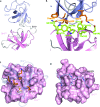Structural basis for regulation of the Crk signaling protein by a proline switch
- PMID: 21131971
- PMCID: PMC3039521
- DOI: 10.1038/nchembio.494
Structural basis for regulation of the Crk signaling protein by a proline switch
Abstract
Proline switches, controlled by cis-trans isomerization, have emerged as a particularly effective regulatory mechanism in a wide range of biological processes. Here we report the structures of both the cis and trans conformers of a proline switch in the Crk signaling protein. Proline isomerization toggles Crk between two conformations: an autoinhibitory conformation, stabilized by the intramolecular association of two tandem SH3 domains in the cis form, and an uninhibited, activated conformation promoted by the trans form. In addition to acting as a structural switch, the heterogeneous proline recruits cyclophilin A, which accelerates the interconversion rate between the isomers, thereby regulating the kinetics of Crk activation. The data provide atomic insight into the mechanisms that underpin the functionality of this binary switch and elucidate its remarkable efficiency. The results also reveal new SH3 binding surfaces, highlighting the binding versatility and expanding the noncanonical ligand repertoire of this important signaling domain.
Figures







Comment in
-
Structural biology: The twist in Crk signaling revealed.Nat Chem Biol. 2011 Jan;7(1):5-6. doi: 10.1038/nchembio.504. Nat Chem Biol. 2011. PMID: 21164511 No abstract available.
Similar articles
-
Proline cis-trans isomerization controls autoinhibition of a signaling protein.Mol Cell. 2007 Feb 9;25(3):413-26. doi: 10.1016/j.molcel.2007.01.004. Mol Cell. 2007. PMID: 17289588 Free PMC article.
-
Prolyl cis-trans Isomerization as a molecular timer in Crk signaling.Mol Cell. 2007 Feb 23;25(4):483-5. doi: 10.1016/j.molcel.2007.02.005. Mol Cell. 2007. PMID: 17317620
-
Molecular dynamics of the proline switch and its role in Crk signaling.J Phys Chem B. 2014 May 1;118(17):4535-45. doi: 10.1021/jp5013297. Epub 2014 Apr 16. J Phys Chem B. 2014. PMID: 24702481 Free PMC article.
-
Commentary: The carboxyl-terminal Crk SH3 domain: Regulatory strategies and new perspectives.FEBS Lett. 2012 Aug 14;586(17):2615-8. doi: 10.1016/j.febslet.2012.04.040. Epub 2012 May 2. FEBS Lett. 2012. PMID: 22710158 Review.
-
[Structural basis for the transforming activity of human cancer-related signaling adaptor protein Crk].Tanpakushitsu Kakusan Koso. 2008 Feb;53(2):148-56. Tanpakushitsu Kakusan Koso. 2008. PMID: 18240594 Review. Japanese. No abstract available.
Cited by
-
Structure and activity of the peptidyl-prolyl isomerase domain from the histone chaperone Fpr4 toward histone H3 proline isomerization.J Biol Chem. 2013 Sep 6;288(36):25826-25837. doi: 10.1074/jbc.M113.479964. Epub 2013 Jul 25. J Biol Chem. 2013. PMID: 23888048 Free PMC article.
-
Cis phosphorylated tau as the earliest detectable pathogenic conformation in Alzheimer disease, offering novel diagnostic and therapeutic strategies.Prion. 2013 Mar-Apr;7(2):117-20. doi: 10.4161/pri.22849. Epub 2012 Nov 15. Prion. 2013. PMID: 23154634 Free PMC article.
-
Structural Basis of TRPV4 N Terminus Interaction with Syndapin/PACSIN1-3 and PIP2.Structure. 2018 Dec 4;26(12):1583-1593.e5. doi: 10.1016/j.str.2018.08.002. Epub 2018 Sep 20. Structure. 2018. PMID: 30244966 Free PMC article.
-
Phosphorylation of Crk on tyrosine 251 in the RT loop of the SH3C domain promotes Abl kinase transactivation.Oncogene. 2011 Nov 17;30(46):4645-55. doi: 10.1038/onc.2011.170. Epub 2011 May 23. Oncogene. 2011. PMID: 21602891 Free PMC article.
-
Assessing Trans-Inhibition of OATP1B1 and OATP1B3 by Calcineurin and/or PPIase Inhibitors and Global Identification of OATP1B1/3-Associated Proteins.Pharmaceutics. 2023 Dec 31;16(1):63. doi: 10.3390/pharmaceutics16010063. Pharmaceutics. 2023. PMID: 38258074 Free PMC article.
References
-
- Feller SM. Crk family adaptors-signalling complex formation and biological roles. Oncogene. 2001;20:6348–71. - PubMed
-
- Miller CT, et al. Increased C-CRK proto-oncogene expression is associated with an aggressive phenotype in lung adenocarcinomas. Oncogene. 2003;22:7950–7. - PubMed
-
- Nishihara H, et al. Molecular and immunohistochemical analysis of signaling adaptor protein Crk in human cancers. Cancer Lett. 2002;180:55–61. - PubMed
-
- Linghu H, et al. Involvement of adaptor protein Crk in malignant feature of human ovarian cancer cell line MCAS. Oncogene. 2006;25:3547–3556. - PubMed
Publication types
MeSH terms
Substances
Associated data
- Actions
- Actions
- Actions
Grants and funding
LinkOut - more resources
Full Text Sources
Other Literature Sources
Molecular Biology Databases

